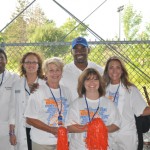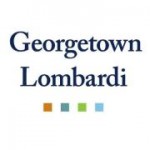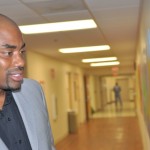Team Draft’s National Campaign Cancer Tours Lombardi – Inside GUMC – Georgetown University Medical Center GUMC
Saturday, June 30th, 2012Inside GUMC – Georgetown University Medical Center GUMC.
Team Draft Tours Lombardi
.jpg)
A radiant, smiling picture of former NFL linebacker Chris Draft’s wife Keasha was never far from sight as he toured Georgetown Lombardi Comprehensive Cancer Center on June 21.
As Draft walked through the clinic and the new state-of-the-art infusion center, full of questions about the facility and kind words for the patients he encountered, he would frequently pull up Keasha’s photos on his iPad to show those around him.
Looking at her youthful, healthy images, it is difficult to believe Keasha passed away from lung cancer at age 38 on December 27, 2011 – one month to the day after she and Draft were married. A former dancer, Keasha had never smoked and had always been physically active and fit before she was diagnosed with stage IV small cell lung cancer.
Draft, who retired from the NFL in 2010 after playing for numerous teams including the Washington Redskins, hopes people will stop in disbelief when they hear his and Keasha’s story and see her pictures. That’s part of his goal.
“I am determined to show a new face of lung cancer. I’m not trying to make it anything other than what it is, but want to make sure we tell the complete story,” Draft said during his visit.
Telling the Complete Story
The “complete story” is that lung cancer can affect anyone – including nonsmokers like Keasha. In fact, it is among the biggest killers out there – accounting for more deaths than breast, prostate, colon, liver, kidney and skin cancers combined. Draft wants to shatter the misconception that people who get lung cancer somehow have brought it on themselves through smoking or other adverse behaviors.
Now devoting much of his time to building awareness of the disease and raising funds for research through his Chris Draft Family Foundation, Draft is on the road a lot these days, visiting cancer centers nationwide in an effort to spread a message of hope about the progress of lung cancer research.
While at Georgetown Lombardi, he met with members of the senior leadership team and interested researchers. Unassuming and approachable, Draft came alone, armed with just his iPad, a camera and a hand-held video camera.
He filmed a short video of Deepa Subramaniam, M.D., assistant professor in the division of hematology/oncology, discussing the vast heterogeneity of lung cancer types and the promise of personalized medicine.
According to Subramaniam, lung cancer in people who have never smoked accounts for approximately 15 percent of all lung cancer cases now. The incidence among nonsmokers and women is on the rise, and researchers are learning just how distinct the disease can be from patient to patient, and from tumor to tumor.
Individualized therapies that target unique tumor characteristics will be the answer to responding to this scourge, Subramaniam said, and to forging a “new paradigm in the classification of lung cancer.”
“We will gradually chip away at each slice of the lung cancer pie. We are going to cure those who can be cured, and convert the disease in those who cannot be cured into a chronic disease,” she said.
To view Draft’s video of Subramaniam, visit http://www.thedraftreport.net/?p=1259.
For more information on Draft’s foundation and the national campaign to change the face of lung cancer, visitwww.teamdraft.org.
By Lauren Wolkoff, Georgetown Lombardi Comprehensive Cancer Center








